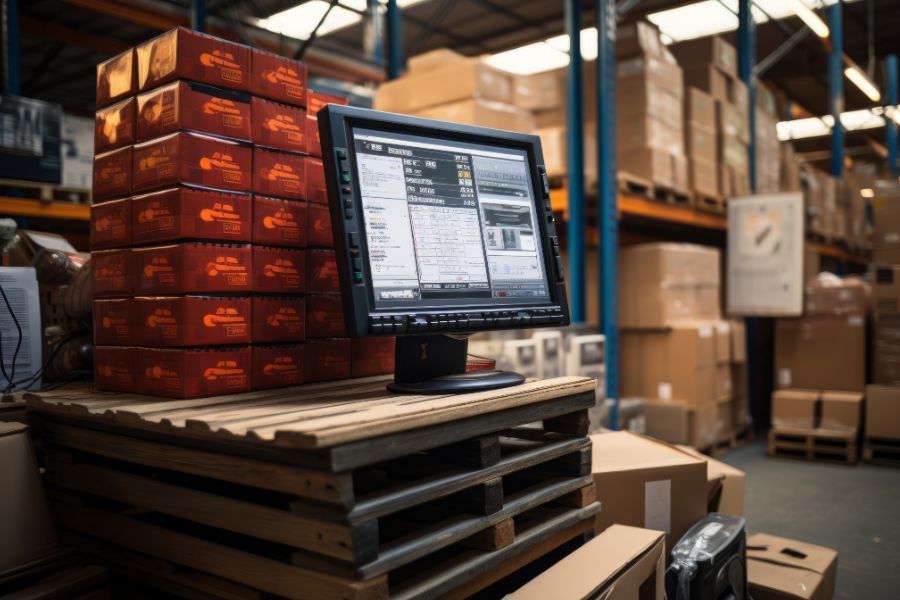Efficiency and customer satisfaction hinge on the seamless execution of the order fulfillment process within retail. This essential journey, which begins at the point of sale and ends with a product’s delivery, is the lifeblood of commerce. This guide will delve into the seven critical steps of the order fulfillment process, explore important considerations to keep in mind and provide best practices to optimize and refine these operations, setting the stage for your business to flourish in the competitive retail landscape.
Why is Order Fulfillment Important for Businesses?
Order fulfillment is the complex, end-to-end process that starts when an order is placed and doesn’t end until the customer has their purchase in hand—or, when necessary, returned. This sequence is the heartbeat of any retail operation, and mastering it is non-negotiable for business success.
Here’s why order fulfillment holds such weight:
Customer satisfaction
A swift and accurate fulfillment process is key to customer satisfaction. Timely delivery of the right product affects repeat business and word-of-mouth recommendations, two critical factors for any business’s growth.
Efficiency and cost-saving
An optimized order fulfillment process cuts unnecessary steps, reduces errors, and saves time—translating into significant cost savings. Less time spent on correcting mistakes means more time devoted to growing your business.
Competitive advantage
Businesses that can guarantee quick and reliable delivery set themselves apart from competitors. In an era where consumers expect rapid gratification, efficient fulfillment can be a deciding factor for customers choosing where to shop.
Scalability
A well-structured order fulfillment process is easier to scale up as your business grows. If each step is clearly defined and efficient, increasing order volumes can be managed more easily without a drop in service quality.
7 Steps in the Order Fulfillment Process
Step 1: Receiving Inventory
The process starts with receiving the goods. This step involves verifying the inventory against the purchase orders, inspecting for damage, and updating stock records. Efficient receiving sets the stage for a smooth fulfillment process by ensuring that all items are accounted for and ready for sale.
Step 2: Inventory Storage
Once received, items are systematically stored in the warehouse. Proper storage is crucial for preserving product quality and facilitating quick retrieval. This involves organizing items in a way that reflects their size, sales frequency, and handling requirements, ensuring that the best-selling products are easily accessible.
Step 3: Order Processing
Order processing kicks in when a customer places an order. The item must be located, picked from the shelf, and then moved to the packing area. This step demands a reliable inventory management system to minimize errors and ensure that the correct product is sent to the customer.
Step 4: Order Packing
In packing, items are carefully encased to prevent damage during shipping. This stage must balance protection with cost, using the right amount of packing material and the correct box size. Including the appropriate shipping labels and invoices is also part of this process.
Step 5: Shipping
The shipping phase involves selecting the carrier and sending the order out for delivery. This decision depends on factors like delivery speed, cost, and the destination of the package. The goal is to deliver the product within the promised time frame while managing shipping costs.
Step 6: Delivery
Delivery is the culmination of the order fulfillment process. It is when the customer finally receives the product. Ensuring the delivery is on time and that the product arrives in perfect condition is vital for maintaining customer satisfaction and trust.
Step 7: Returns Processing
Handling returns is the final step of the order fulfillment process. A clear and efficient returns process is essential for customer service. It involves receiving returned items, assessing their condition, processing refunds or exchanges, and updating inventory accordingly.
By thoroughly understanding each step of the order fulfillment process, businesses can optimize their operations, reduce costs, maintain high customer satisfaction levels, and ultimately enhance their market position.
Key Challenges in Order Fulfillment & How To Solve Them
Now you have learned the order fulfillment process, time to discover what may come with it.
Below, we explore these challenges in depth, examining the complexities they present, real-world examples, and the best practices to navigate and overcome them effectively.
Challenge 1: Inaccurate Inventory Levels
Maintaining accurate inventory levels is foundational to order fulfillment. Discrepancies can arise from multiple issues, including but not limited to clerical errors, theft, damages, and returns that need to be processed correctly. Inaccurate inventory tracking can lead to situations where sales channels reflect stock that isn’t available, causing backorders, cancellations, and a tarnished brand reputation.
Example
Consider an online electronics store that sells high-demand gaming consoles. Their inventory system mistakenly shows an extra 50 units due to a clerical error. In the peak holiday season, they sell these non-existent units, resulting in a slew of order cancellations. Customers are frustrated, leading to negative reviews and a loss of trust in the brand.
Solution
To combat inventory inaccuracies, businesses should implement a POS system like ConnectPOS, which has an integrated inventory management system that updates in real-time across all sales channels. Regular cycle counting should replace or supplement traditional annual inventory counts. Utilizing technologies like RFID can increase accuracy, and employing predictive analytics helps anticipate demand and adjust inventory levels proactively.
Challenge 2: Picking and Packing Errors
Errors during the picking and packing phase can lead to incorrect orders being shipped out. This results in customer dissatisfaction and increased costs due to returns processing and reshipping. Picking errors often occur when items are mislabeled or poorly organized while packing errors can happen due to oversight or insufficient quality control processes.
Example
Imagine a warehouse worker mistakenly picking a 128GB smartphone instead of the 256GB model ordered by the customer. The error goes unnoticed during packing. The customer receives the wrong item and contacts customer support, which triggers a return and reshipment process that not only delays satisfaction but also doubles shipping costs and handling time.
Solution
Employing a warehouse management system (WMS) that integrates with barcode scanners or RFID technology can drastically reduce picking errors. For packing, implementing automated systems to check weight and dimensions can flag discrepancies before shipping. Additionally, investing in training for warehouse staff and establishing a double-check or peer-review system can further minimize these errors.
Challenge 3: Supply Chain Disruptions
The supply chain is vulnerable to disruptions from various external factors, including natural disasters, geopolitical events, or supplier bankruptcies. These disruptions can halt or delay the flow of goods, leading to inventory shortages and fulfillment delays.
Example
A furniture retailer relies on a single supplier for a popular line of desks. Unexpectedly, a political conflict interrupts trade routes from the supplier’s country. The retailer struggles to fulfill orders due to the sudden stop in supply, leading to backorders and customer complaints.
Solution
Diversifying suppliers across different geographic regions can mitigate risk. Establishing strong relationships with multiple carriers and having backup logistics plans are also crucial. Businesses should consider investing in supply chain visibility tools that provide real-time insights into potential risks, allowing for proactive mitigation strategies.
Challenge 4: Shipping Complexities
Shipping involves navigating a maze of carriers, service levels, and constantly fluctuating rates, compounded by customer expectations for fast and free delivery. International shipping adds layers of complexity with customs, duties, and international regulations, which can lead to delays and additional costs.
Example
A small business expanding its market internationally faces challenges with cross-border shipping. A shipment gets held up in customs because the proper duties were not paid, and the paperwork needed to be completed. The customer experiences significant delays, and the business incurs additional fines and fees.
Solution
Leverage multi-carrier shipping software that automatically selects the best carrier for each shipment based on cost and delivery time. Stay informed about international shipping practices, and consider working with customs brokers to navigate international shipping regulations. Offer customers a range of shipping options, setting clear expectations about delivery times and costs.
Challenge 5: Returns Management
Returns are inevitable, especially in e-commerce, and managing them effectively is challenging. The process can be complex, involving reverse logistics, quality checks, restocking, and potential losses on damaged goods. A cumbersome returns process can also deter customers from future purchases.
Example
A fashion retailer experiences a high volume of returns due to sizing issues with a new clothing line. Customers find the process tedious as they must call customer service to initiate a return, wait for an email with the shipping label, and then send the items back without a clear timeline for the refund.
Solution
Implement a streamlined and customer-friendly returns process into your POS system. This could include easy-to-print return labels, clear instructions on the website, and immediate refund or replacement upon return confirmation. Analyzing return data to understand and address the root causes can also reduce the overall volume of returns. Consider a portal that allows customers to manage returns themselves, increasing efficiency and customer satisfaction.
Challenge 6: Customer Service and Communication
Effective communication and customer service are pivotal in order fulfillment, yet many businesses need help with these aspects, particularly during peak seasons or when issues arise. Poor communication can lead to customer dissatisfaction, as buyers are left in the dark about the status of their orders or are not promptly informed about issues such as delays or backorders.
Example
During the holiday season, a surge of orders overwhelms a retailer’s customer support. A glitch in the notification system fails to send order confirmation and shipping emails. Customers, uncertain about their order status, flood the customer service lines. The support team is unable to keep up, resulting in long response times and increased customer frustration.
Solution
Invest in a customer service platform that can scale with demand and integrate with the order management system to provide real-time order information. Automated updates and self-service options, like chatbots and FAQs, can alleviate the burden on customer service teams. Training staff to handle common issues and ensuring they have access to the necessary information can improve response times and customer satisfaction. Additionally, proactive communication strategies, such as alerting customers to potential delays before they become issues, can enhance the overall customer experience.
Takeaway Notes
To effectively manage order fulfillment, businesses must confront a myriad of challenges head-on. By understanding the nuances of inventory accuracy, refining picking and packing protocols, preparing for supply chain volatility, mastering the intricacies of shipping, and streamlining returns and customer service, companies can turn potential obstacles into opportunities for growth and customer engagement. Embracing best practices and leveraging technology to enhance these areas will not only drive efficiency but also build trust with customers. As the marketplace continues to evolve, those who prioritize and adeptly manage these aspects of order fulfillment will distinguish themselves as leaders in service excellence and reliability.
A robust POS system is indispensable in streamlining an effective order fulfillment process, acting as the central hub for sales, inventory management, and customer data. Explore ConnectPOS’s capabilities to elevate your fulfillment strategy, integrating seamlessly with your operations to enhance efficiency and customer satisfaction.



